CENTRAL PORTUGAL GASTRONOMY AND THE CUISINES OF THE BEIRAS REGION
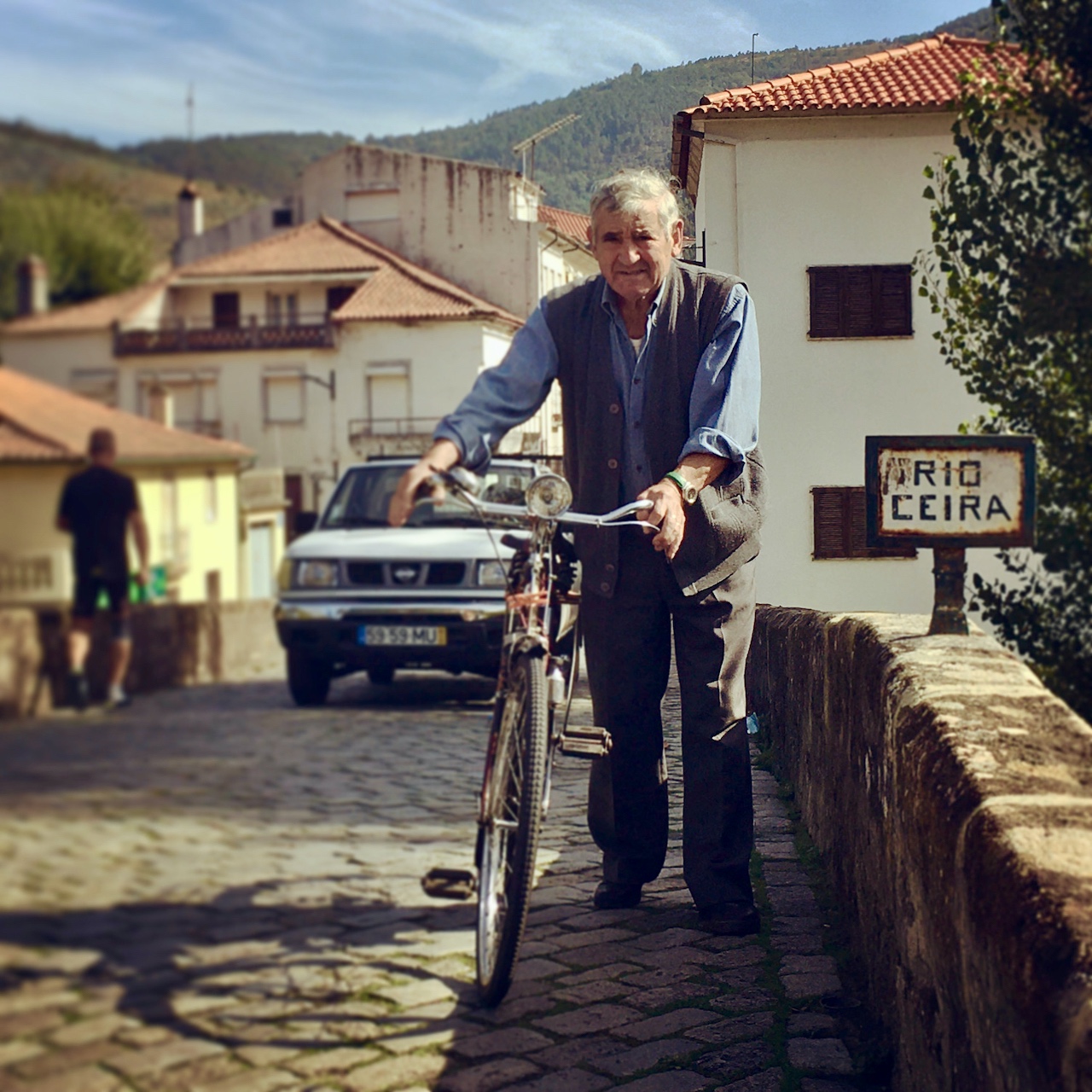
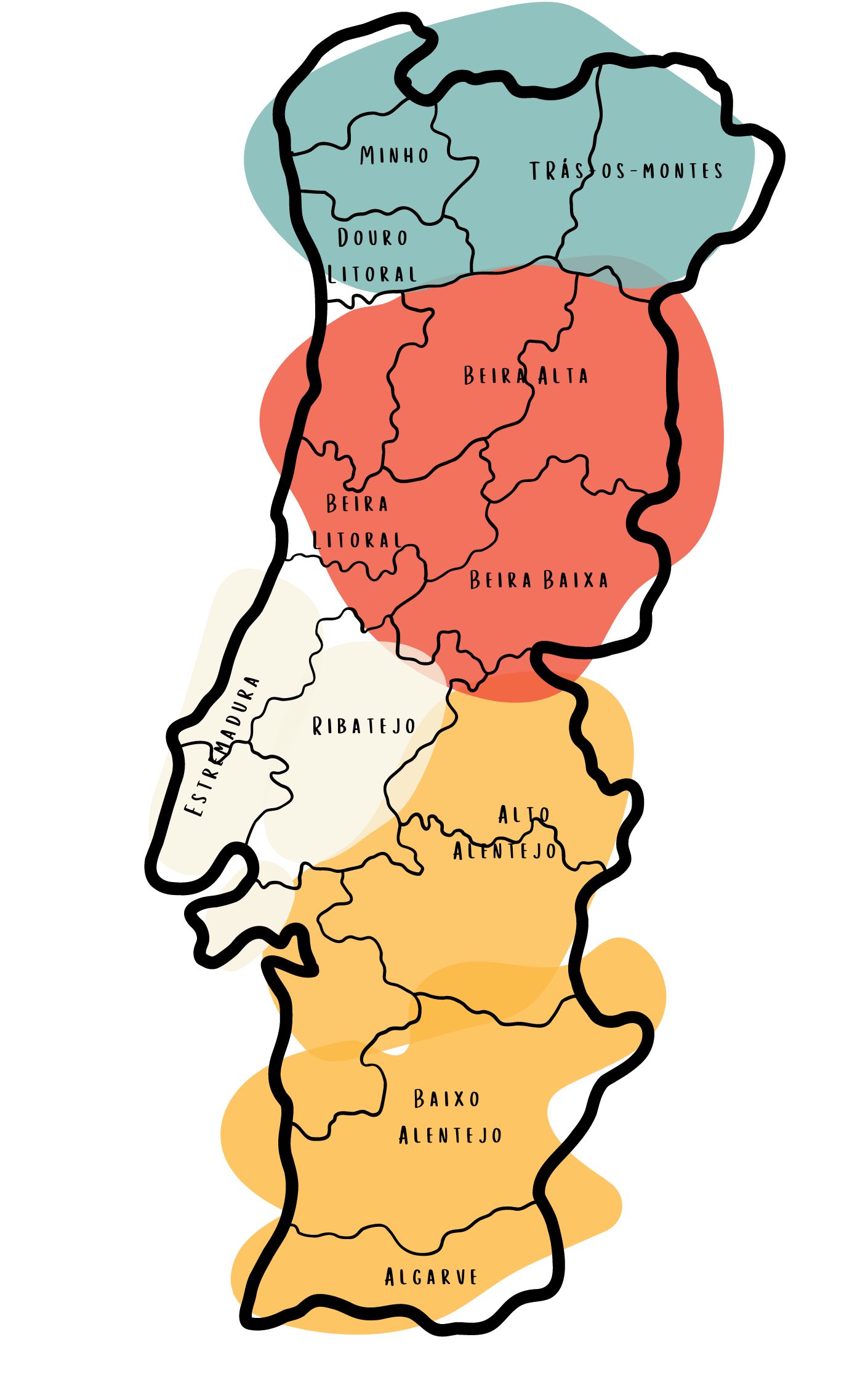
The Beiras region of northeast and central Portugal are one of the least explored parts of our country, particularly by international visitors. This certainly has no direct correlation with its dramatic (and varied) scenery, rich traditions, strong culture and delightful cuisine. On the contrary, traversing from the mountains all the way to the coast, the Beiras encompass an incredible range of landscapes, typical ingredients and quintessential dishes.
Geographically speaking, the Centre of Portugal is divided into the regions of Beira Alta, Beira Baixa and Beira Litoral (see the map). Even though the food and culture heritage of this area of Portugal, just like elsewhere in the country, surpasses these fabricated borders, we have divided our food explorations below per area, yet grouping the more inland provinces of Beira Alta and Beira Baixa together, as to simplify the task of doing a proper overview and condense here all the delectable foods and drinks which you should try, and which are evocative of the region.
The history of this region, particularly marked by the passage of Romans, Moors and influenced by neighboring Spain, explains some of its favorite foods. But the ingredients that have become day-to-day in the Beiras probably have even more to do with its topography (which includes mainland Portugal’s highest mountain, Serra da Estrela) and climate, which range from snowy winters to intense hot summers.
Traveling around the center of Portugal, and especially in the interior of the country, is almost like taking a trip back in time. You will come across barely untouched countryside terrains, villages that haven’t changed all that much since Medieval times, and even traditional foods which could certainly remind us of a time gone by.
Beiras Alta and Beira Baixa: mountain foods, sheep cheeses and Dão wines
The geography of Beira’s traditional cuisine
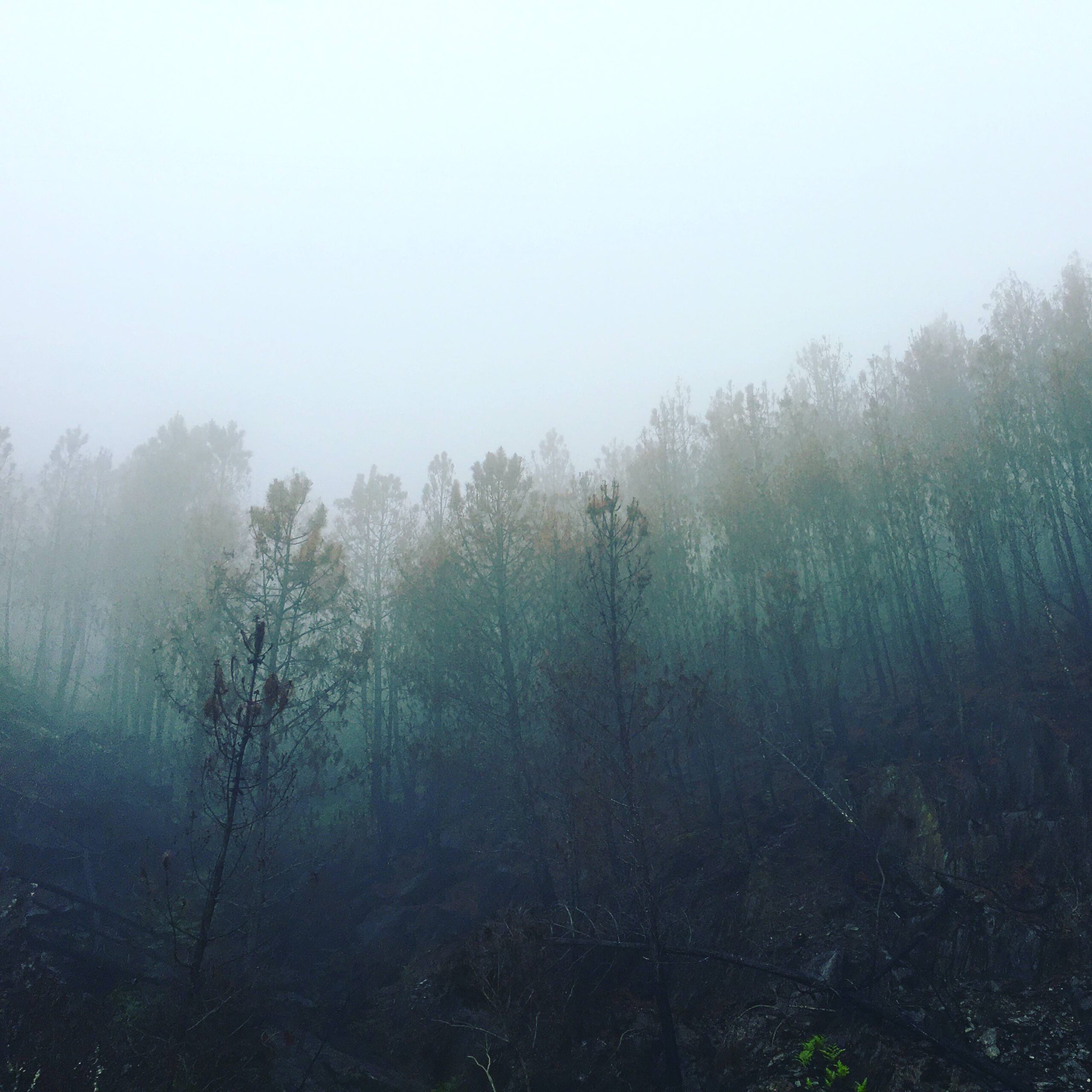
Foggy mountains during a road trip through Beiras, near Seia.
The mountains from the inland Beiras region have a rich cuisine, which manages to set itself apart from most of Portugal’s fare. The rural exodus which has seen a lot of smaller villages from this part of Portugal get deserted, has taken a lot of the old-time recipes a little all over the country, and so now we can all enjoy Portuguese dishes nationwide, no matter their place of origin.
The cuisine of this region is strongly influenced by Serra da Estrela, the highest mountain in mainland Portugal, just after mount Pico in the Azores. The highlands associated with their typical cold weather call for hearty and caloric meals, particularly involving meats and dairy such as those from goat and sheep, which thrive in the hilly lands.
There are several species of goat indigenous from this area, and which are now-a-days grown as cattle for meat, with IGP (protected geographical indication) label. We’re talking about cabrito da Beira IGP (goatling), borrego da Beira IGP (lamb) and borrego da Serra da Estrela (lamb from Serra da Estrela’s mountain range). Out of all the goat dishes from this region, Chanfana is quite possibly the most popular. The recipe calls for an old goat, roasted inside a typical clay pot in a wood oven. The meat is seasoned with red wine, garlic, bay leaf and salt, which is a blend of spices known in Portuguese as vinha-de-alhos, and which is in the inception of the popular vindaloo from India, which resulted from the arrival of the Portuguese in Goa back in the 15th century. Historically, chanfana was a dish that aimed to make the most of an aged goat which no longer produces milk or goatlings, and thus required proper marinating and cooking time for the meat to be tender. Now-a-days, some chanfana recipes may bring together goat, sheep and pork meat on the same clay vessel. The town of Miranda do Corvo has claimed the title of “Chanfana capital”, but this is a dish you’ll be able to taste in many of the region’s restaurants.
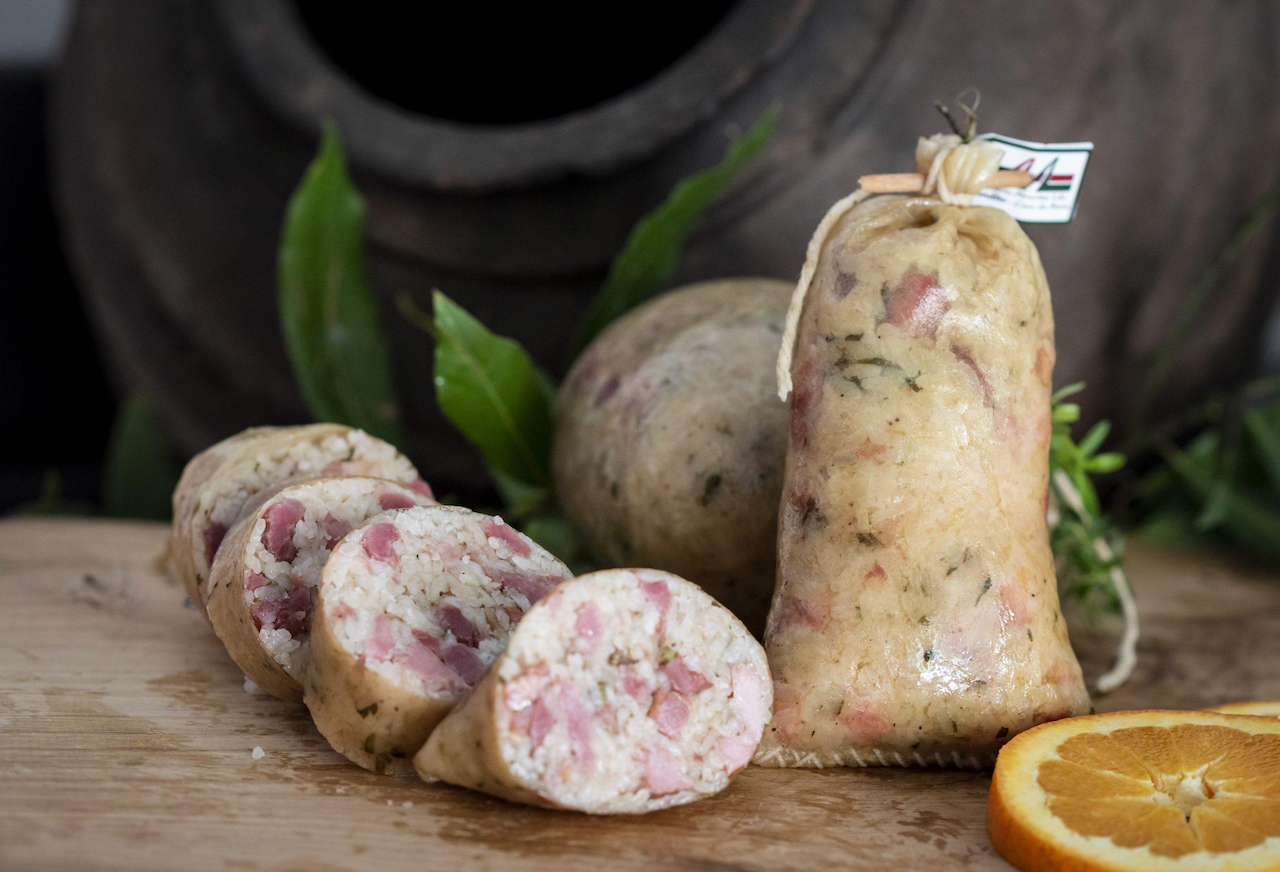
The traditional ‘maranho’.
The pastoral traditions of this part of Portugal also explain dishes such as maranho. Linked to the town of Sertã but, truly, beloved all over the region, maranho consists of a goat’s stomach (known in Portuguese as bucho), stuffed with goat meat, cured ham and rice. It is seasoned with white wine, paprika, parsley and spearmint, used to add freshness to an otherwise heavy meat dish. Maranho is boiled and it can be eaten on its own with potatoes and vegetables as side dishes, or even added to recipes such as cozido à Portuguesa. In some butcher shops and even supermarkets in the Beira Baixa area of Portugal, you’ll find ready-made maranho, which you only have to boil at home prior to eating – this will not be the case elsewhere in Portugal, so make the most of the opportunity to taste a truly unique Portuguese dish, also available on the menu of local restaurants focusing on traditional foods.
Aside from goat, other popular meats around the mountains of the Beiras include sheep (mostly as a part of chanfana); rabbit (like in the rabbit and white wine dish coelho das Beiras); game meats (like partridge, wild boar and, to a lesser extent, even deer); veal (like the vitela de Lafões, succulent meat which resulted from crossing the breeds Mirandesa and Arouquesa, conventionally roasted in the oven with white wine and potatoes); and pork. Pig farming is behind the regional charcuterie prepared in this part of Portugal, with particular emphasis on bucho (also known as bucho de Arganil or bucho da Sertã). Bucho consists of a pig’s stomach stuffed with a variety of other meats like pork and chicken, along with eggs, wheat bread, rice of the Carolino grain variety, and flavorings such as orange juice, white wine, garlic, parsley, salt, pepper and nutmeg. The stomach is rubbed with lard and paprika powder and taken to the oven to slowly roast until the fillings are fully cooked and the outer skin is crispy. Bucho is eaten sliced, like a meatloaf, and it is most commonly served on festive days. This is one of those regional dishes which you will not easily come across in the rest of Portugal, so if you happen to be visiting Beira Baixa, particularly around Sertã, make sure you look for a restaurant which serves it.
Beira’s traditional fish dishes
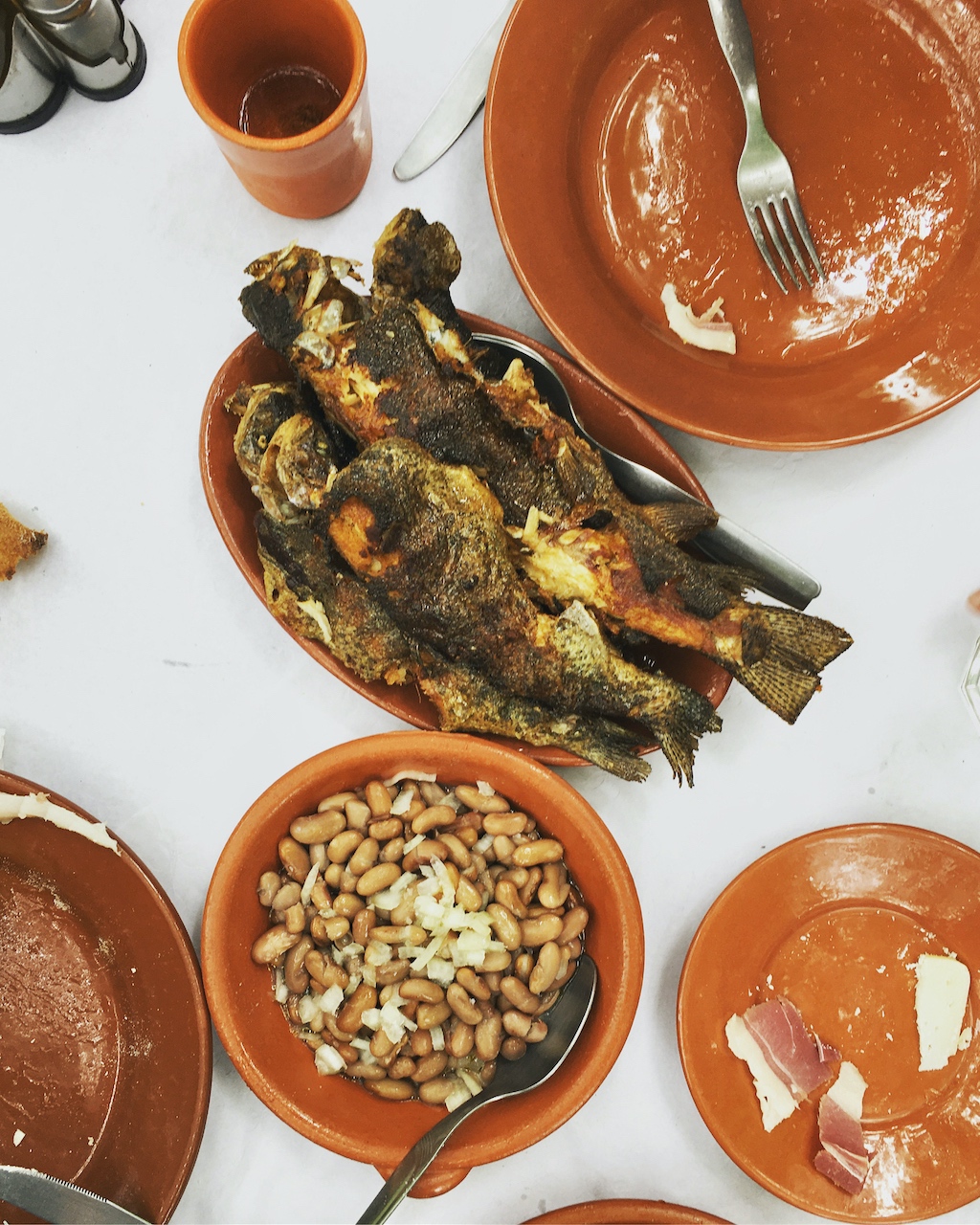
For us this is an unmissable stop in Beiras to taste the local farmed trouts, cooked by Carlos and eaten under the trees facing the river!
In case you were wondering, there certainly is more than meat dishes in the interior center of Portugal! While there’s no access to the sea, and historically speaking fish was mostly consumed cured (hence explaining the local love for dishes such as roasted salt cod, that is, bacalhau assado no forno, or bacalhau à lagareiro, roasted cod with garlic infused olive oil), there are many rivers which are sources of water for agriculture but also of freshwater fish. Similarly to the Minho region of Portugal, lamprey season starts at some point in February, and while it doesn’t last for more than a couple of months, it’s a time for feasting, not just amongst locals, but also for people from the neighboring regions who flock to cities such as Tomar for this delicacy. While in the Minho the most typical way of eating lamprey will have it cooked along with rice, arroz de lampreia, here in the Beiras lamprey is best enjoyed as lampreia à bordalesa, a lamprey stew served with slices of toasted bread all around the serving tray, which are used to soak up the juices.
Besides lamprey, other freshwater delicacies of the region include enguias, that is, eels, usually prepared as ensopado de enguias (soupy eels stew served atop slices of bread) or as caldeirada de enguias, also known as caldeirada de enguias à moda de Aveiro. Eels stew Aveiro style is a typical dish from the city of Aveiro which we explore in more detail in the second part of this article, and which brings together in a pot eels from the estuary of Aveiro, cooked similarly to a caldeirada, but with a distinct yellow color which is granted by the addition of saffron to the recipe. Enguias are also very popular in their tinned variety, which features plain eels as well as fried eels in vinegary escabeche sauce.
Olive oil and bread keep a nobleman fed
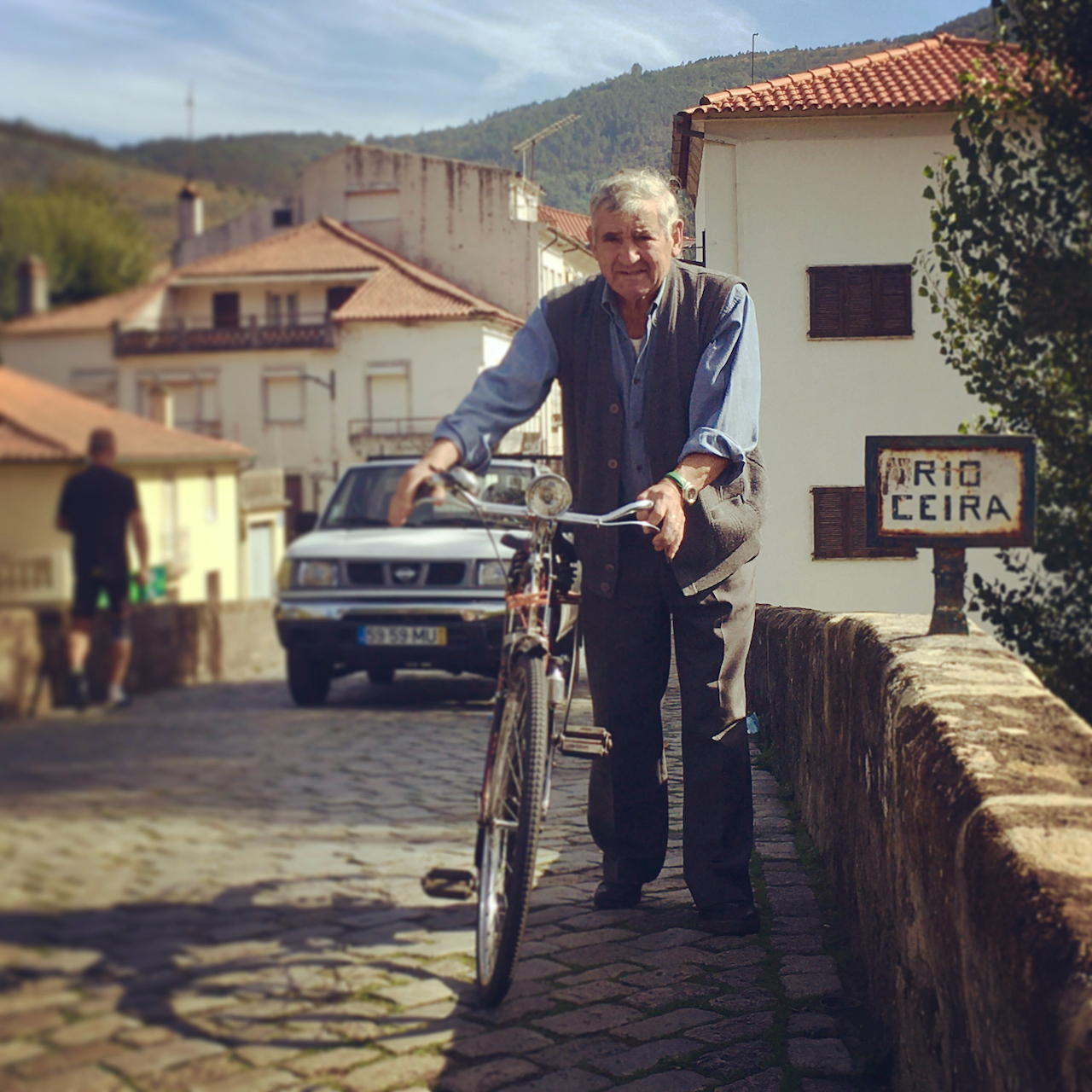
Lousã, where Silvia’s father was born.
This popular Portuguese saying clearly highlights the importance of the golden juice of the fruit of the olive tree, which has historically been a staple ingredient of the Portuguese diet, transversal to all social classes.
Just like it happens all over Portugal, olive oil is essential to cooking in the Beiras region of Portugal. Azeites da Beira Interior are high quality olive oils with a protected denomination of origin, grown in an area with a landscape also picturesquely dotted by its cork trees. Beira Interior olive oils are obtained from pressing local olive varieties such as Galega, Verdeal Cobrançosa and Cordovil, from Beira Baixa and Beira Alta. These oils are known for their fruitiness, distinct aroma, a light color which ranges between yellow and greenish, and particularly because of their low level of acidity.
Olive oil is used for cooking and seasoning savory dishes, but also to prepare confections like biscoitos de azeite. These olive oil biscuits are straightforward wheat biscuits that use olive oil instead of butter for fat, and while they’re not something you’ll find in restaurants in the Beiras, you can certainly buy them in local shops and bakeries as they make a great snack to munch on as you explore the region.While olive oil is indeed great as a base for biscuits and even drizzled atop some fresh bread, such as the bica d’azeite, a flatbread typical from the region of Castelo Branco, which can be traced to the Jewish community inhabiting this region, cheese is indeed the topping of choice for bread.
Where sheep cheese is king!
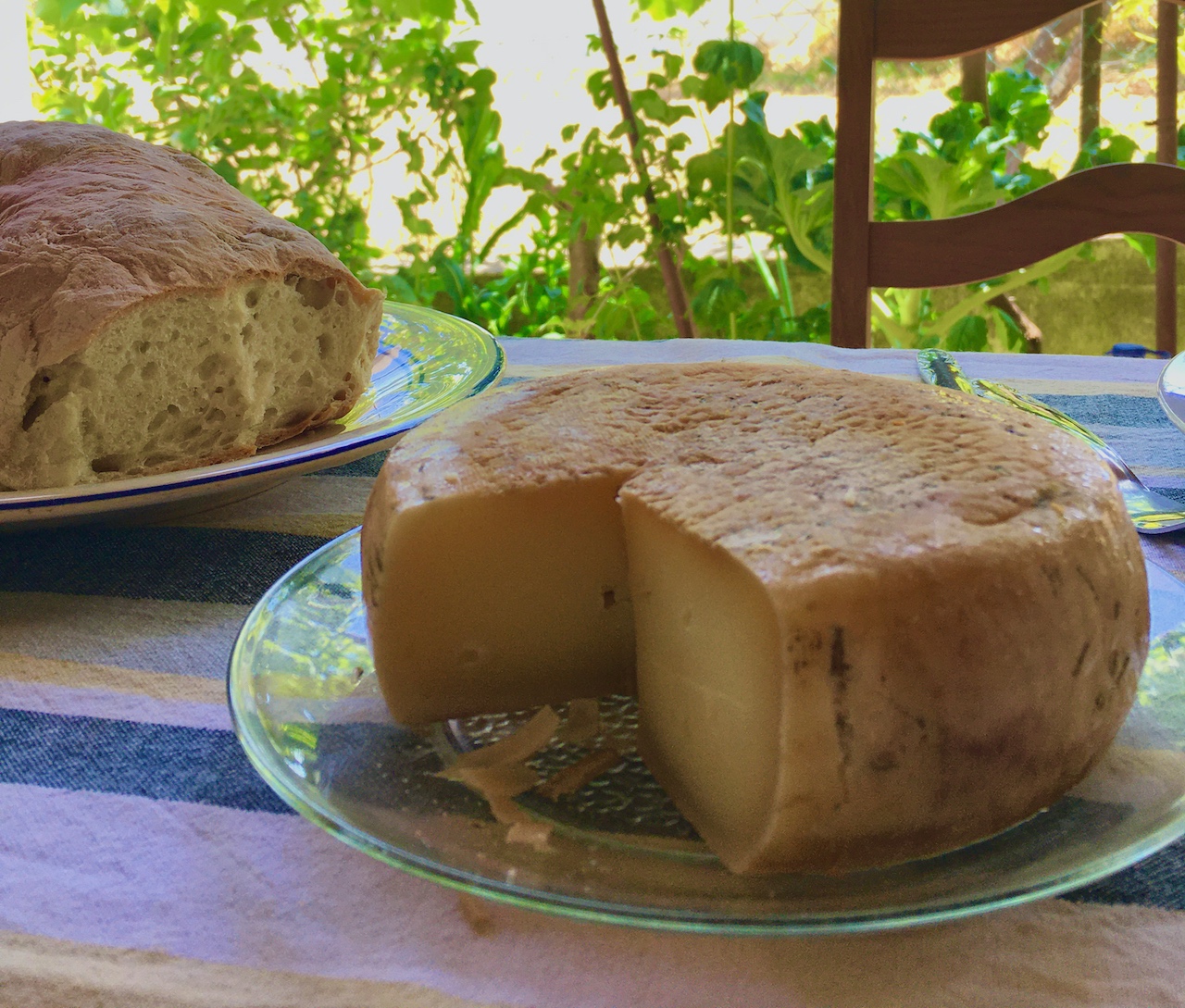
The lovely and intense Castelo Branco cheese
The most famous cheese from this region, also happens to be one of Portugal’s most famous cheeses: queijo da Serra da Estrela, that is, sheep milk cheese from Serra da Estrela mountain range. Queijo da Serra, as it’s most commonly known in short, has a protected designation of origin granted by the European Union and it is manufactured in a delimited geographical area, following very meticulous rules. The raw sheep milk used comes from only two local breeds of free-ranging naturally fed sheep, Bordaleira da Serra da Estrela and Churra Mondegueira, and it is curdled with thistle flower (as it does not contain animal rennet, Serra da Estrela is considered a vegetarian cheese) and left to cure for at least thirty days. Serra da Estrela cheese can range from buttery, to semi-hard and even extra hard, known in Portuguese as queijo Serra da Estrela velho. But its most popular variety is the young semi-liquid cheese which, as it can’t be sliced, it’s scooped out of its shell, opening a lid on the top of the cheese wheel. Serra da Estrela is the oldest Portuguese cheese and you can find it all over the country. But while visiting the Serra da Estrela mountains you can get up close to the way it is produced, either visiting a cheese maker or the Cheese Museum of Pêraboa in Covilhã, but also participating in dedicated cheese tastings, which happen in places such as Manteigas and Celorico da Beira.
Besides queijo da Serra da Estrela, other notable cheeses from the center of Portugal include queijo Seia, a cured yet buttery sheep milk cheese from the town of Seia; queijo Rabaçal, a semi hard cheese made with a blend of sheep and goat milks; and queijo de Castelo Branco, an intense ripe cheese from the city by the same name, prepared with sheep milk, and with a slightly buttery texture.
Beira’s most representative Portuguese desserts
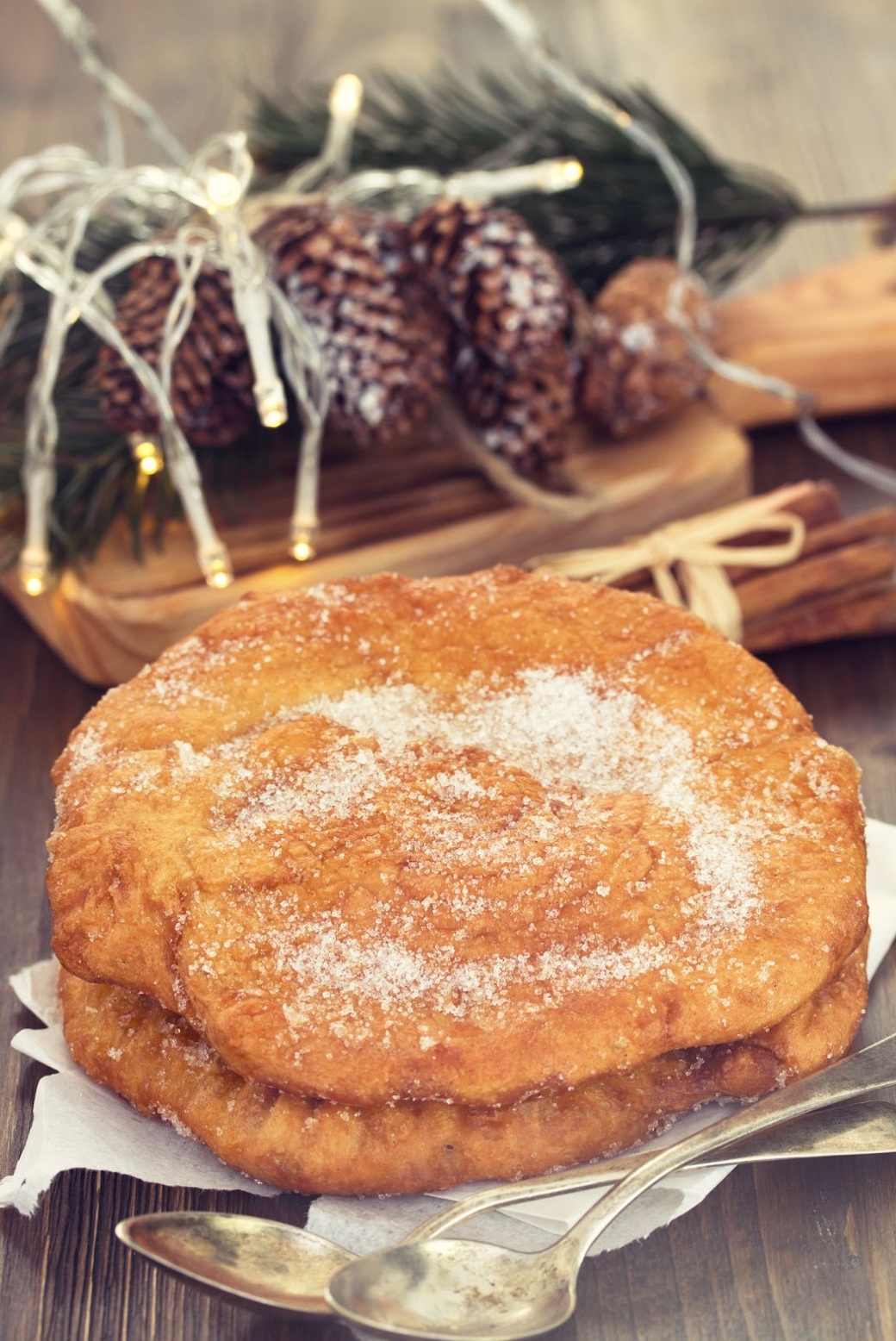
‘Filhoses’
When it comes to desserts, one of the most distinctive sweet dishes you’ll find in the Beira Alta and Beira Baixa regions of Portugal, and which you hardly ever find elsewhere in Portugal, are papas de carolo. Also known as papas de milho, or corn porridge, this is a very simple recipe which came about because of this area’s high production of corn. Papas de carolo are prepared with corn flour, milk, sugar and aromatics like citrus zest and cinnamon stick, heated together until thick, and are habitually served in clay bowls. Bigger clay bowls are used to make tigelada, another typical dessert from the Beiras region, which reiterates the Portuguese love for custard in all its shapes and forms. TIgelada is one of the quintessential desserts from the city of Castelo Branco, and consists of an oven baked custard prepared with milk, sugar and eggs, which has a rustic look and is extremely satisfying after a typical meal.
Porridges and custards aside, the Beiras region is also known for its filhoses (or filhós), which are sweet dough fritters which the rest of Portugal also eats particularly during religious festivals, such as those around Easter and Christmas. Filhoses da Beira Baixa, as they are properly known, are somehow similar to the internationally known malassadas, and consist of a dough made with wheat flour, butter, eggs, sugar, aromatic and a little bit of brandy. They are deep-fried and best still warm with a little sugar and cinnamon sprinkled on top, and so comforting on a cold day in the mountains along with a cup of tea, or, for a boozy experience, with a glass of Licor Beirão, a brand of sweet liqueur from the Beiras, produced with a secret blend of aromatic herbs and spices, best enjoyed on the rocks.
Dão wine region: unexplored unique wines
Even though it is overshadowed by the Douro to its north, the Dão is one of the oldest established wine regions in Portugal. This is where Touriga Nacional, one of Portugal’s most influential autochthonous grape varieties, is originally from, and which also happens to be one of the defining grapes of the famous fortified Port wine. The lands of the Dão DOC region are mostly granite soils, which give the wines minerality and brightness on the palate. The Dão Wine Route, put together by local players under the Regional Wine Commission of Dão supervision, recommends 17 different wineries which you can visit to try Dão wines and learn more about the winemaking process in this region of Portugal.
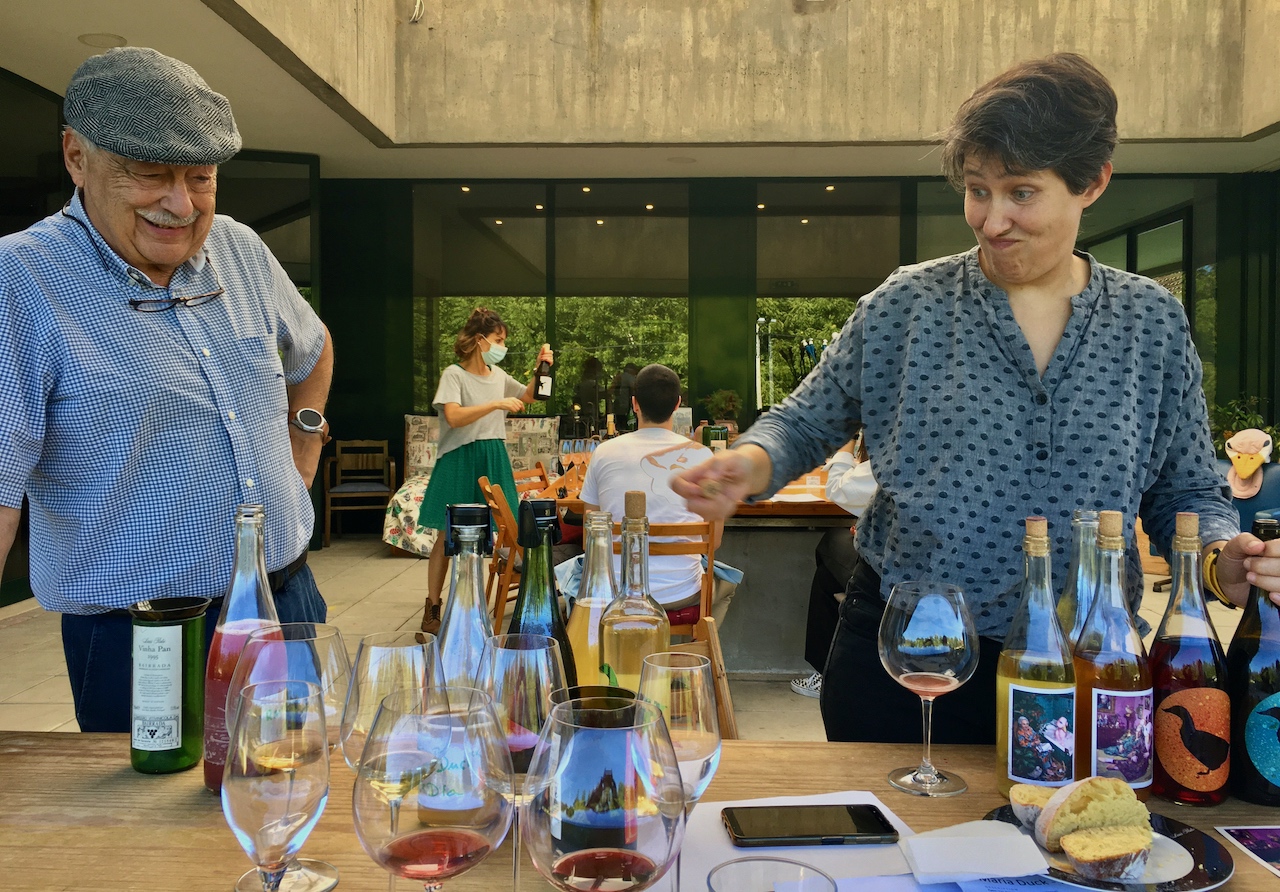
Our beloved Luís Pato and his daughter Maria Pato whom we admire by her spontaneity, originality and amazing wines. One of the most important wine families in Portugal.
Beira Litoral: from suckling pigs to ovos moles
Traditional dishes and confections from the coast in the Centre of Portugal
Spanning about 200 km of Portugal’s coastline, to the south of Porto and before reaching the north of the Greater Lisbon area, the Beira Litoral region is dotted with cities and towns known for its fishing traditions and maritime related trade.
The city of Coimbra is the capital of Beira Litoral and it serves as the connecting dot between the mountainous inland and the actual coast. Coimbra is home to one of the world’s oldest universities, Universidade de Coimbra, so even though the city has about 140,000 permanent residents, it feels busier during the school year, as young people from all over the country settle here for their higher education. History buffs will have a great time around Coimbra, particularly exploring the ancient Roman ruins of Conimbriga, which we could look at as the Portuguese equivalent of Pompei in Italy. Those who are more into natural beauty can connect at Serra do Bussaco, where the omnipresent brand of Portuguese spring water Luso comes from. No matter if you are a city or countryside kind of traveler, one thing is for sure: in and around Coimbra, just like all over Beira Litoral, you can dine and wine and feel divine!
The kingdom of suckling pigs
Just thirty minutes drive to the north of Coimbra, you can visit the Bairrada region (with a protected denomination of origin since 1980), which is home to wines popular inside Portugal, particularly the red variety made with Baga grapes. These deep red colored wines can be still or sparkling, and  are usually paired with the region’s most acclaimed speciality, leitão à Bairrada (also known as leitão da Bairrada or leitão assado). Spit-roasted suckling pig is one of those dishes that Portuguese folks are willing to travel to eat, and the pilgrimages usually happen to places such as Mealhada or Pombal, in the central region of Portugal, or Negrais, closer to Lisbon. Leitão da Bairrada was voted by Portugal’s population as one of the Seven Wonders of Portuguese Gastronomy, along with alheira de Mirandela, cheese from Serra da Estrela, caldo verde, traditional seafood rice, grilled sardines and pastel de Belém. Leitão is basically a roasted baby pig, which can be eaten hot, lukewarm or even cold, and it’s normally served with potato chips and perhaps some side salad or orange slices to help cut the fattiness of the dish. The meat is juicy and the outer skin crispy, and the flavors vary according to the type of wood chosen for the cooking process. Suckling pigs have been cooked this way in the Bairrada region since the 1700s, and this is hands down one of the most representative dishes of Portuguese cuisine you can enjoy in the Beiras region. If by any chance you’re passing by and you’re full from a previous meal, grab a sandes de leitão, a suckling pig sandwich that even roadside stands and petrol stations along the highways in this area will normally sell.
are usually paired with the region’s most acclaimed speciality, leitão à Bairrada (also known as leitão da Bairrada or leitão assado). Spit-roasted suckling pig is one of those dishes that Portuguese folks are willing to travel to eat, and the pilgrimages usually happen to places such as Mealhada or Pombal, in the central region of Portugal, or Negrais, closer to Lisbon. Leitão da Bairrada was voted by Portugal’s population as one of the Seven Wonders of Portuguese Gastronomy, along with alheira de Mirandela, cheese from Serra da Estrela, caldo verde, traditional seafood rice, grilled sardines and pastel de Belém. Leitão is basically a roasted baby pig, which can be eaten hot, lukewarm or even cold, and it’s normally served with potato chips and perhaps some side salad or orange slices to help cut the fattiness of the dish. The meat is juicy and the outer skin crispy, and the flavors vary according to the type of wood chosen for the cooking process. Suckling pigs have been cooked this way in the Bairrada region since the 1700s, and this is hands down one of the most representative dishes of Portuguese cuisine you can enjoy in the Beiras region. If by any chance you’re passing by and you’re full from a previous meal, grab a sandes de leitão, a suckling pig sandwich that even roadside stands and petrol stations along the highways in this area will normally sell.
Ingredients of the coast of Beira Litoral
Once you properly reach the coast of Beira Litoral, you can stop by cities such as Aveiro, Ílhavo and Figueira da Foz, to concentrate on all things seafood, including arroz de marisco, or Portuguese seafood rice, which is believed to have originated in Praia da Vieira, a beach area near Leiria (which technically falls under the province of Estremadura, whose cuisine we explore in detail in our following article). Not only along the Beiras coast you’ll find amazing Atlantic fish, crustaceans and mollusks, the Aveiro region is also known for its artisanal salt production, where some of the finest Portuguese flor de sal (aka fleur de sel) comes from. You can visit the Salinas de Aveiro to learn more about the tasks involved in salt extraction and processing, and buy a bag of incredible plain or flavored salt to take home with you.
Beira Litoral’s conventual sweets
When it comes to sweets, many of Beira Litoral’s most famous confections are indeed some of Portugal’s most beloved sweets. We’re talking particularly about conventual sweets, which bring together astonishing amounts of egg yolks, sugar and a few other ingredients.
In Coimbra itself, you find pastéis de Santa Clara, delicate half moon shaped confections with a filling of sweet egg yolks and almonds. Tentúgal, very close to coimbra, is home to the homonymous pastéis de Tentúgal, a recipe developed by Carmelite nuns in the 16th century. What may seemingly look like fairly simple pockets of flaky pastry with egg jam filling, are actually the result of one of the most intricate processes of Portuguese pastry making, stretching the dough to inimaginable lengths – places that produce pastéis de Tentúgal today have full sized rooms dedicated to gracefully stretching the ultra thin dough on the covered floor, across several meters.
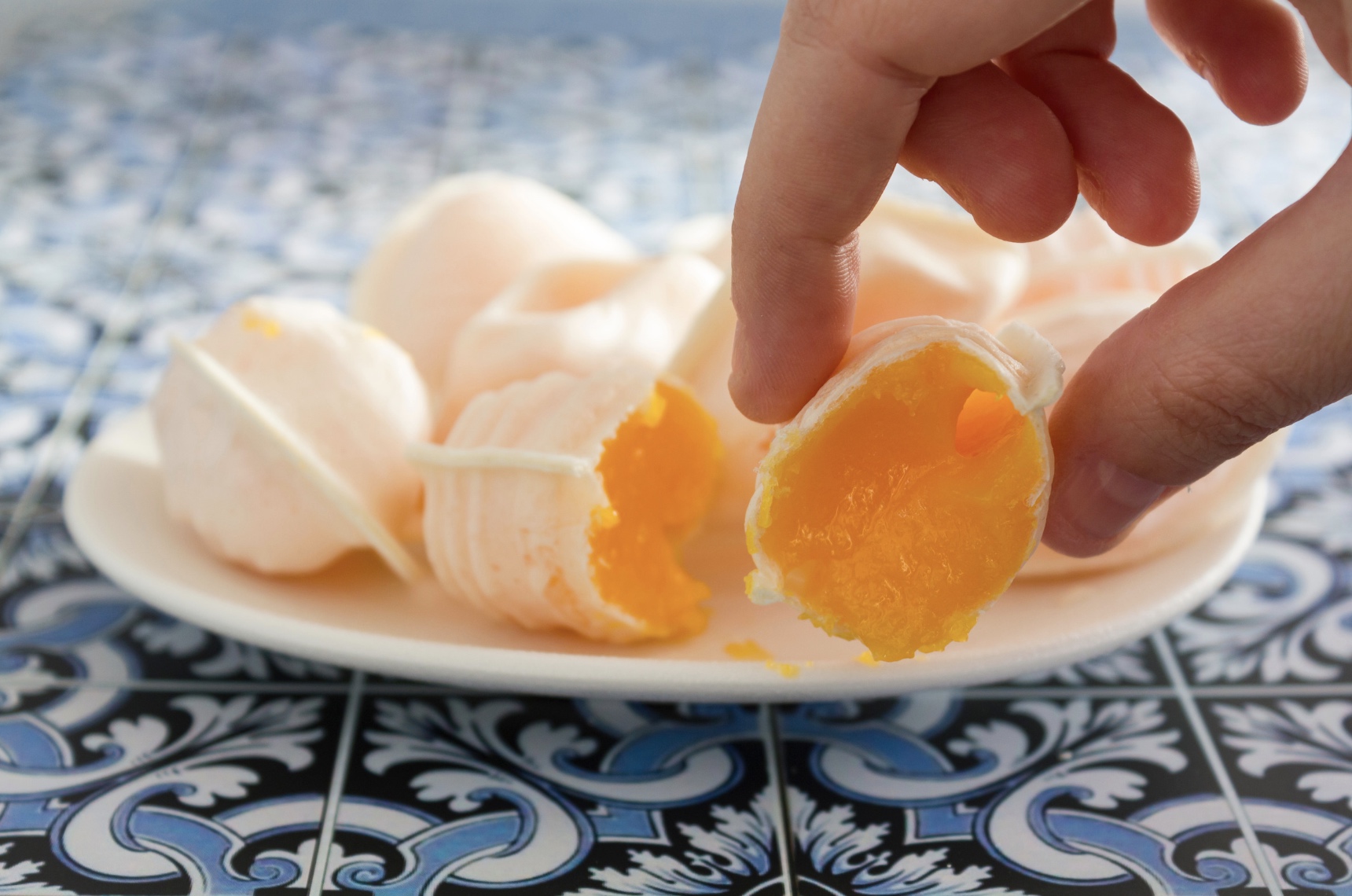
‘Ovos moles’ de Aveiro
Ovar, a city in the district of Aveiro, is synonymous with pão de ló de Ovar, a delicacy which is often translated to English as Portuguese sponge cake but, when cooked right, is spongy on the outside yet creamy and slightly runny on the center. Pão de ló, which has been protected with a denomination of origin label since 2016, is a centuries-old recipe which was taken by the Portuguese to Japan, which adapted the recipe and turned it into kasutera cake.
It’s in Aveiro which we find one of the highest expressions of Portuguese sweet making coming out of convents, and that is ovos moles, also known as ovos moles de Aveiro. Ovos moles come about when you mix egg yolks and sugar and slowly cook this mix, but you need to know how to do so in a skilled manner. In fact, this is exactly the secret behind Portuguese conventual sweet making – thanks to different sugar cooking techniques known as pontos de açucar, or sugar points, the Portuguese are able to turn the same ingredients into differently flavored and textured products. Creamy ovos moles are traditionally covered with an exceptionally thin wafer, shaped with sea inspired motifs like conch, and sold in wood or porcelain barrels decorated with paintings allusive to the cityspace of Aveiro and its canals. These confections whose name translates as soft eggs, have existed for about half a millennium, thanks to the Carmelite, Franciscan and Dominican nuns which first came up with the recipe, and from the 19th century onwards, with the dissolution of religious orders, thanks to the bakeries and confectioners which started selling ovos moles and greatly contributed to their popularization in the region and all over Portugal.
Still in the Beiras of Portugal, another sweet worth trying while exploring the region include barrigas de freira from Anadia (also known as nun bellies, or freirinhas, little nuns) and which consist of incredible amounts of egg yolks cooked with sugar and a little water, cooked inside a copper pot greased with butter.
Last but not least… the best cherries in Portugal!
If sweets are not your preferred method of sweeting the palate, when summer comes around, do not miss out on the absolutely gorgeous cherries from Fundão. The production of this fruit is tightly controlled as cerejas do Fundão have IGP status, that is protected geographical indication, and result in juicy, deeply flavored cherries which enjoy an amazing reputation all over Portugal.
As you can see, the center of Portugal may be an area less explored by tourists which often make their way directly from Lisbon to Porto, or vice-versa, but who are then bypassing all the goodness of the Beiras which we recommend you indulge on, particularly if you are a food and wine loving traveler!
Itinerary overview for a food trip in the Centre of Portugal
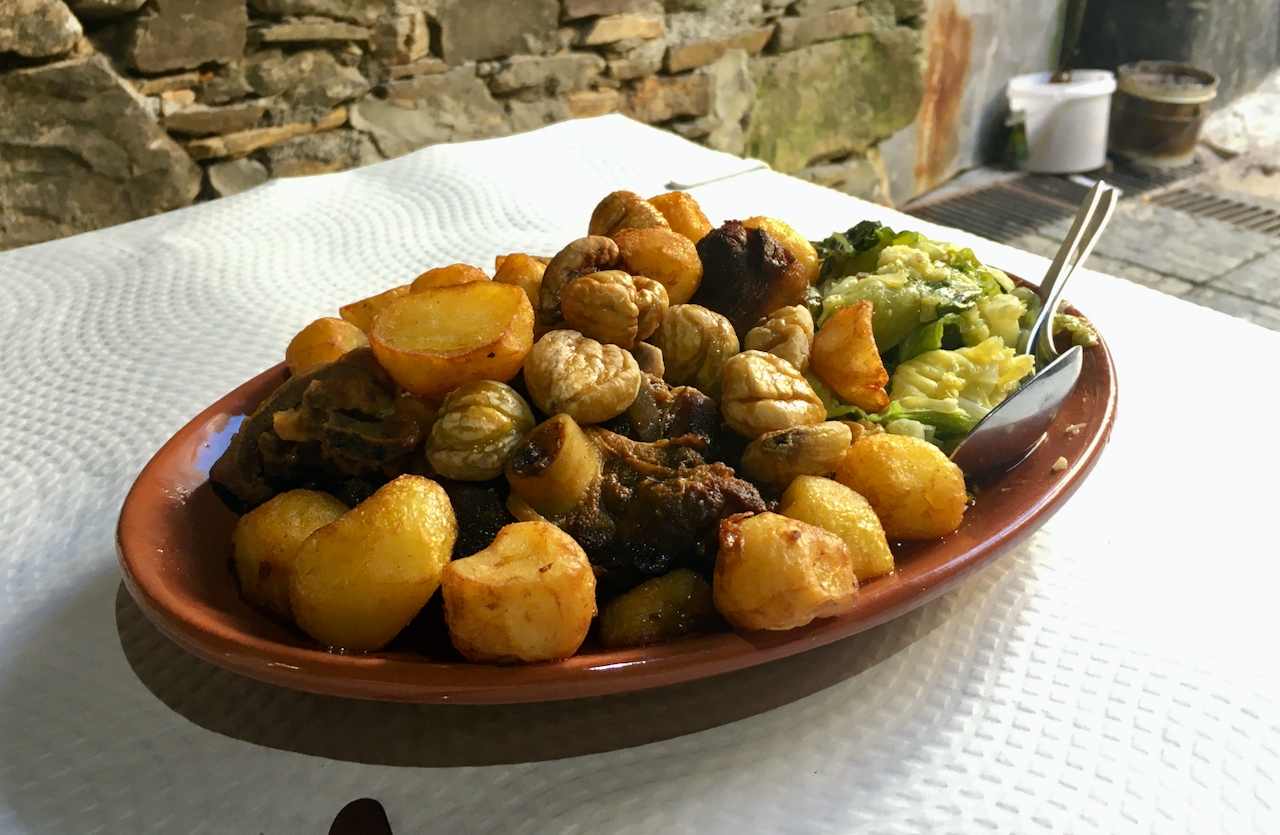
Beira goatling served at a restaurant near Colmeal village.
Most characteristic places you should visit:
- The “Aldeias Históricas de Portugal” (a collection of 12 picturesque historical villages, with several UNESCO World Heritage sites)
- Côa Valley (to visit the extensive open-air Paleolithic archaeological site, famous for its rock art)
- Viseu
- Serra da Estrela Natural Park
- Ovar
- Coimbra
- Aveiro
- Figueira da Foz
- Castelo Branco
Must-eat traditional foods:
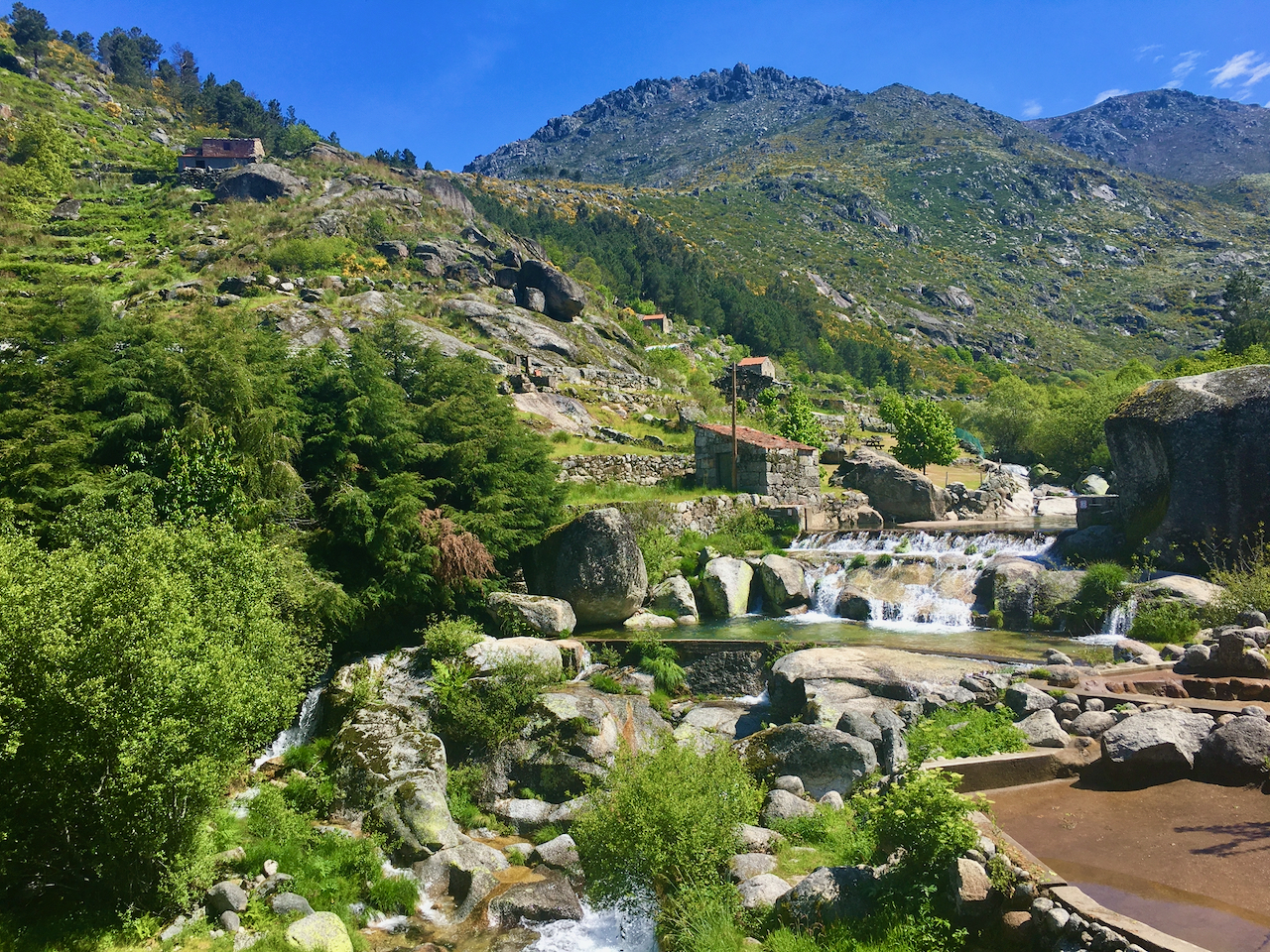
In Beiras, during summer, you can find several natural pools with fresh river water. This one is the
- Sheep cheese from Serra da Estrela
- Bucho
- Maranho
- Caldeirada de enguias
- Vitela à Lafões
- Bairrada style spit-roasted suckling pig
- Pão de ló from Ovar
- Ovos moles from Aveiro
- Pastéis de Santa Clara
- Tigelada
- During summer, cherries from Fundão
Typical drinks to try:
- Wines from the Dão region
- Beira Interior wines
- Wines from the Bairrada region
- Licor Beirão
Off-the beaten path culinary treasures:
- Visit Casa da Ínsua and learn how to make your own Serra da Estrela cheese from scratch;
- Indulge at Mesa de Lemos, the only Michelin starred restaurant in the central region of Portugal, where chef Diogo Rocha offers a couple of tasting menus with elevated regional cuisine, paired with wines grown in their own vineyards;
- Schedule a trip to Adega23, a winery from the Vinhos das Beiras region, which is an up-and-coming Portuguese wine-growing area with a very particular terroir – here you can do a vineyard tour, wine tasting, workshop, or even a enjoy a picnic at the vineyards!
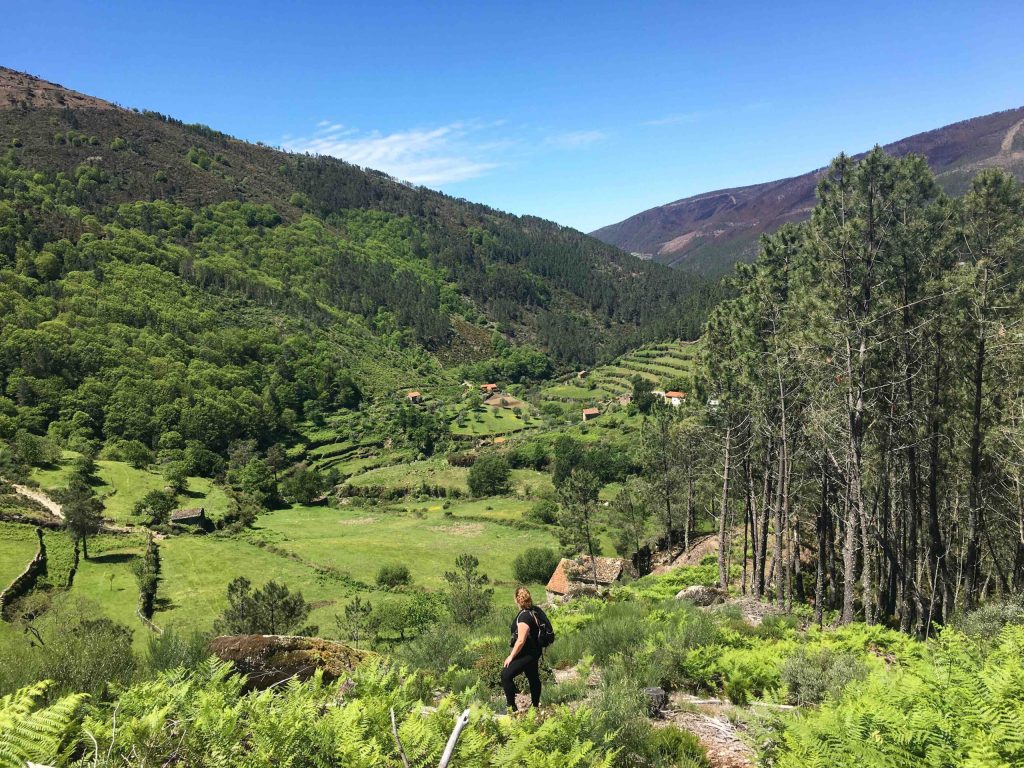
Natacha during one of our trekkings. All types of walks are available, from easy to hard. In common, they all have stunning landscapes.
Article by :
Zara Quiroga (freelance food writer and food & cultural leader at Oh! My Cod Pico Trips)
Photos by:
Sílvia Olivença (anthropologist and food guide/CEO at Oh! My Cod Ethnographic Food Tours & Trips)
Want to more about Portuguese cuisine?
Pico Wine: one of the world’s most unique wine regions (Genesis – Part I)
